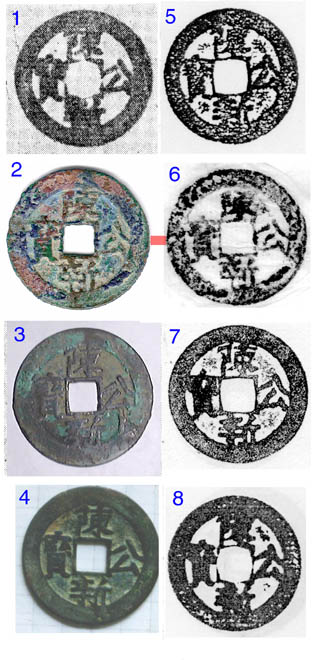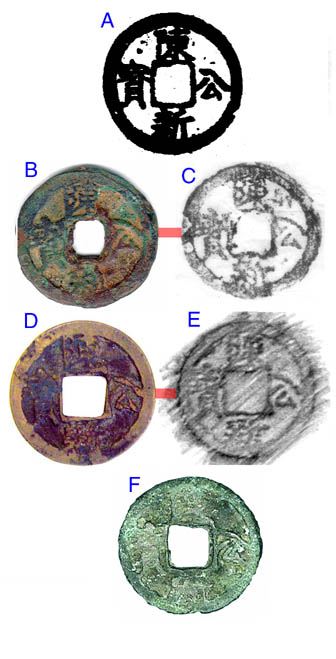 |
 |
LIST OF ILLUSTRATIONS Type I rubbings
Type I actual pieces
Type II rubbings and pieces A) Rubbing from Ding Fu Bao
|
Tran Tan Cong Bao (1511 / 1516
AD)
(real coins and forgeries)
Tran Tan Cong Bao has long been held as one of the great rarities of all ancient Vietnamese coins, by Chinese, Japanese, and Vietnamese collectors alike. Ding Fu Pao rated the coin as one of the rarest of all, assigning it a value of 200 yuan, higher than the price assigned to either Thuan Thien Dai Bao or Thien Cam Nguyen Bao. Unfortunately such celebrated rarities are often faked, and Tran Tan Cong Bao is no exception.
More fortunately, a careful examination of several authentic as well as fake pieces, and a study of the literature reveals that there is a significant difference between the authentic pieces and most fakes. This makes the fakes easy to spot, at least for now. In general all rubbings from the literature and known pieces fall into one of two categories, and here they will be referred to as type I and type II.Several rubbings and images of pieces are illustrated in the two figures below. These have been divided into type I in the first figure and type II in the second. For the sake of discussion type I pieces have been labeled from 1 to 8 and type II pieces have been labeled from A to F. If a rubbing corresponds to an actual coin in the figure, the two are attached with a red bar. There are several distinctions between these type I and type II coins. Type I coins all have a broad outer rim, a small inner rim, and are extremely well made. All the type II coins have a narrow outer rim, large inner rim, and are of poor manufacture. The most fundamental difference is that the calligraphy of the two types are very different, particularly the critical character Cong.
Its easy to make the argument that type I pieces represent authentic coins and that type II style coins are in general forgeries. Several pieces of evidence supports this idea. First, of the six known independent rubbings found in the literature, all are of type I except the rubbing in Ding Fu Pao. 'Independent' here means a rubbing of a different coin, and which is not simply a copy of a rubbing from a different source. Although the rubbing from Ding has been widely copied into other references, there are no other independent examples of rubbings of this style coin in the literature. The fact that almost all rubbings are of type I is a strong vote for the authenticity of type I coins.
The second piece of evidence is the fine workmanship of the type I coins. Most Vietnamese coins of that era and the preceding 100 years are of superb quality and workmanship, even better than many of the Chinese coins of the time. There is every reason the believe that a real Tran Tan Cong Bao would also be of the same fine workmanship as seen in the type I coins. On the other hand, fakes often tend to be of poorer workmanship and casting. Third, the calligraphy of the character Cong is wrong on the type II pieces according to the way the Chinese strokes should be made. Most obvious is the upper right-hand stroke which should flair outwards as the stroke comes down as it does on the type I coins. However the same stroke on the type II coins slopes the wrong way. This is a large calligraphic error.
Finally the best evidence of all is that examination shows that all the illustrated type I pieces (nos. 2, 3, and 4) are authentic, whereas the type II pieces B, C, and D are either known or thought to be forgeries. Piece B is a recent fake supplied by an unscrupulous individual who in fact knows where it was made, and D, and F are also judged by many to be fake.
So if it is concluded that type I coins are authentic and that type II coins are not, the obvious question is why is Ding Fu Pao's rubbing in the second figure with the other type II pieces? Is it also from a fake? It is of course impossible to answer with great certainty but the question is a valid one. A number of experts whom the author has spoken with have expressed suspicion of the rubbing in Ding's Vietnam section, and it should be pointed out that a few of the other rare Vietnamese coins in Ding are also thought to be fake. These include the Thien Cam Nguyen Bao with the character on the reverse and the seal script Hoang Tran Thong Bao. The most recent edition of Ding includes a comment in the margin stating that latter coin is indeed a fake.
The obvious explanation for why the observed fakes are all of type II style is that Ding Fu Pao is one of the most widely available works that illustrates Tran Tan Cong Bao, where as the other references are either of Japanese origin or from more obscure publications. A forger in China would therefor be most likely to base his evil work on the rubbing in Ding. Is it not impossible that Ding's piece is just another variety not listed anywhere else, and that it has been widely copied by forgers, however there remains the problem of the incorrect calligraphy. Perhaps the best conclusion to come to is, if given an opportunity to buy either a type I or a type II piece, type I is a better bet
 |
 |
LIST OF ILLUSTRATIONS Type I rubbings
Type I actual pieces
Type II rubbings and pieces A) Rubbing from Ding Fu Bao
|
Dr. R. Allan Barker
Singapore
February 2, 2000